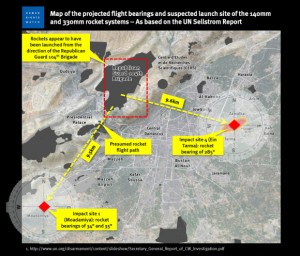NYT Retreats on 2013 Syria-Sarin Claims
Exclusive: Even as The New York Times leads the charge against the Syrian government for this week’s alleged chemical attack, it is quietly retreating on its earlier certainty about the 2013 Syria-sarin case, reports Robert Parry.
The New York Times, which has never heard an allegation against Syrian President Bashar al-Assad that it hasn’t immediately believed, has compiled a list of his alleged atrocities with a surprising omission: the Aug. 21, 2013 sarin gas attack outside Damascus.

A heart-rending propaganda image designed to justify a major U.S. military operation inside Syria against the Syrian military.
Why this omission is so surprising is that the sarin incident was the moment when the Western media and the Washington establishment piled on President Barack Obama for not enforcing his “red line” by launching military strikes against the Syrian government to retaliate for Assad “gassing his own people.”
The retaliation, which would have pummeled the Syrian military, was hotly desired by neoconservatives and liberal interventionists who were obsessed with achieving another Mideast “regime change” even if that risked turning Syria over to Al Qaeda and/or the Islamic State. The story of Obama’s supposed “red line” retreat has become a treasured groupthink of all the “important people” in D.C.
So, for the Times to compile a summary of alleged Assad atrocities, which included a separate section on “chemical attacks,” and to leave out the August 2013 case suggests that even The New York Times cannot sustain one of the most beloved myths of the Syrian war, that Assad was at fault for the sarin attack.
Previously, the Times backed away from one of its front-page reports – published about a month after the sarin attack – that used a “vector analysis” to place the site of the sarin missile launch at a Syrian military base about 9 kilometers from the two impact zones. That analysis was considered the slam-dunk proof of Assad’s guilt, but it collapsed when it turned out that one of the missiles contained no sarin and the other rocket, which did have sarin, had a range of only about 2 kilometers, placing the likely firing location in rebel-controlled territory.
Hersh’s Findings
Investigative journalist Seymour Hersh further demolished the Assad-sarin myth in an article that traced the chemicals back to Turkish intelligence, but the mainstream U.S. media was so hostile to any dissenting view on the Assad-did-it groupthink that Hersh had to publish his findings in the London Review of Books. Later, Turkish police and opposition officials corroborated much of Hersh’s findings – and I’ve been told that U.S. intelligence analysts now agree, at least generally, with Hersh’s conclusions.
But the Times never directly repudiated its earlier accusations against Assad’s military, thus allowing the groupthink to be sustained that Assad was responsible for the 2013 attack. That history became important again on Tuesday when another incident – also apparently involving sarin or a similar poison gas – claimed lives in an Al Qaeda-dominated area of northern Syria.
The U.S. mainstream media (along with President Trump and his top aides) immediately blamed Assad again, with Trump and his team threatening to launch a retaliatory military strike even without the approval of the United Nations Security Council. The 2013 case loomed large in the background with Trump implicitly referencing Obama’s presumed failure to enforce his “red line.”
Prominent U.S. news personalities, such as MSNBC’s Andrea Mitchell, also have cited the old Assad-was-guilty-in-2013 conventional wisdom to buttress their new rush to judgment over the Tuesday incident. Indeed, the 2013 sarin case has become a perfect example of how the major U.S. media often jumps to conclusions and then refuses to back down regardless of the ensuing evidence.
But now we have the Times’ list of alleged Assad atrocities, compiled by Russell Goldman, a senior staff editor on the International Desk, that doesn’t allege that Assad or his forces were responsible for the 2013 sarin attack.
Goldman reports: “In the latest attack on civilians, more than 100 people, including children, were believed to have been killed by chemical weapons in a rebel-held town in Idlib Province on Tuesday. A doctor there said the victims’ pupils were reduced to pinhole-size dots, a characteristic of nerve agents and other banned toxic substances.
“The United States put the blame for the attack on the Syrian government and its patrons, Russia and Iran, and suggested that the salvo was a war crime. While the attack was among the deadliest uses of chemical weapons in Syria in years, it was far from an isolated case.
“During the war, the Assad government has been accused of regularly using chlorine gas, which is less deadly than the agent used on Tuesday and is legal in its commercial form. According to the Violations Documentation Center, an antigovernment watchdog, more than 1,100 Syrians have been killed in chemical weapons and gas attacks.”
The reference to the anti-Assad group’s claim about the 1,100 Syrians allegedly killed by chemical weapons would presumably include the 2013 sarin incident, although local medical personnel put the death toll much lower, at perhaps several hundred. But note how the Times used a passive tense in describing those deaths – “more than 1,100 Syrians have been killed” – without attribution of who did the killing.
And nothing specific at all about the 2013 sarin case and who was responsible.
The Chlorine Cases
The chlorine-gas cases have resulted in only a few fatalities, which also undercuts the claims that the Assad government was responsible for them. Why would Assad risk more outside military intervention against his government by using a chemical weapon that has almost no military value, at least as allegedly deployed in Syria?

The controversial map developed by Human Rights Watch and embraced by the New York Times, supposedly showing the flight paths of two missiles from the Aug. 21, 2013 Sarin attack intersecting at a Syrian military base.
U.N. investigators – under intense pressure from the West to find something that could be pinned on Assad – agreed to blame him for a couple of the chlorine allegations coming from rebel forces and their civilian allies. But the U.N. team did not inspect the sites directly, relying instead of the testimony of Assad’s enemies.
In one of the chlorine cases, however, Syrian eyewitnesses came forward to testify that the rebels had staged the alleged attack so it could be blamed on the government. In that incident, the U.N. team reached no conclusion as to what had really happened, but neither did the investigators – now alerted to the rebels’ tactic of staging chemical attacks – apply any additional skepticism to the other cases.
In one case, the rebels and their supporters also claimed to know that an alleged “barrel bomb” contained a canister of chlorine because of the sound that it made while descending. There was no explanation for how that sort of detection was even possible.
Yet, despite the flaws in the rebels’ chlorine claims – and the collapse of the 2013 sarin case – the Times and other mainstream U.S. news outlets report the chlorine allegations as flat-fact, without reference to sourcing from the U.N. investigators whose careers largely depended on them coming up with conclusions that pleased the majority of the five-member Security Council – the U.S., Great Britain and France.
If this fuller history were understood, much greater skepticism would be warranted by the new allegations about Assad ordering a new sarin attack. While it’s conceivable that Assad’s military is guilty – although why Assad would take this risk at this moment is hard to fathom – it’s also conceivable that Al Qaeda’s jihadists – finding themselves facing impending defeat – chose to stage a sarin attack even if that meant killing some innocent civilians.
Al Qaeda’s goal would be to draw in the U.S. or Israeli military against the Syrian government, creating space for a jihadist counteroffensive. And, as we should all recall, it’s not as if Al Qaeda hasn’t killed many innocent civilians before.
[For more on the mysterious 2013 sarin case, see a memo from U.S. intelligence veterans, “A Call for Proof on Syrian-Sarin Attack.”]
Investigative reporter Robert Parry broke many of the Iran-Contra stories for The Associated Press and Newsweek in the 1980s. You can buy his latest book, America’s Stolen Narrative, either in print here or as an e-book (from Amazon and barnesandnoble.com).




Geen opmerkingen:
Een reactie posten